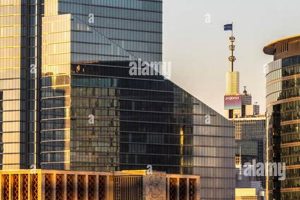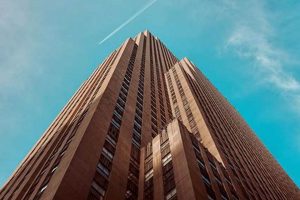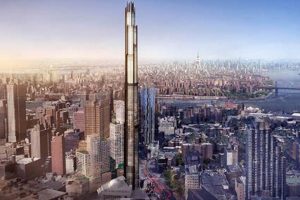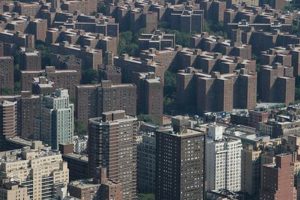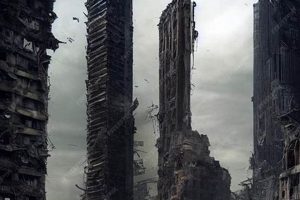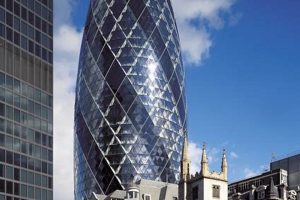A skyscraper is a very tall, continuously habitable building having multiple floors. Skyscrapers are very tall structures that house businesses or residents and are often constructed in densely populated urban areas where land is scarce.
Skyscrapers offer multiple advantages. They can accommodate a large number of people in a relatively small area, which is ideal for densely populated cities. Furthermore, skyscrapers can be designed to be energy-efficient and environmentally friendly, reducing their impact on the environment. Additionally, skyscrapers can be iconic landmarks that define a city’s skyline and contribute to its cultural identity.
The history of skyscrapers dates back to the late 19th century, with the construction of the Home Insurance Building in Chicago in 1885. Since then, skyscrapers have become increasingly tall and sophisticated, with new technologies and architectural designs constantly being developed. Today, skyscrapers are found in cities all over the world and continue to be a symbol of urban development and progress.
1. Height
The height of a skyscraper is one of its defining characteristics. Skyscrapers are typically much taller than other types of buildings, and this height gives them a number of advantages. For example, skyscrapers can accommodate more people and businesses in a smaller area, which is ideal for densely populated urban areas. Additionally, skyscrapers can be designed to be more energy-efficient and environmentally friendly, as they can take advantage of natural ventilation and sunlight. Furthermore, skyscrapers can be iconic landmarks that define a city’s skyline and contribute to its cultural identity.
The height of a skyscraper is also important from a structural standpoint. Taller buildings require more robust structural systems to withstand wind loads and other forces. As a result, skyscrapers are typically constructed using steel or concrete frames, which provide strength and stability. The height of a skyscraper is therefore a critical factor in its design and construction.
In conclusion, the height of a skyscraper is an essential component of its meaning. Skyscrapers are defined by their height, and this height gives them a number of advantages, both functional and aesthetic. When we think of skyscrapers, we think of tall, iconic structures that dominate the skyline and house a variety of businesses and residents. The height of a skyscraper is what makes it a skyscraper, and it is what gives it its unique place in our cities.
2. Floors
The multiple floors of a skyscraper are a key component of its meaning and function. Skyscrapers are able to accommodate a large number of people and businesses in a relatively small area because they have multiple floors. This is ideal for densely populated urban areas, where land is scarce and expensive.
The different floors of a skyscraper can be used for a variety of purposes, including offices, residential units, and retail space. This mixed-use approach is becoming increasingly popular, as it allows people to live, work, and shop in the same building. This can save time and money, and it can also help to create a more vibrant and sustainable community.
The floors of a skyscraper are also important from a structural standpoint. The taller a building is, the more floors it needs to have in order to support its weight. The floors of a skyscraper are typically made of steel or concrete, which are strong and durable materials that can withstand the forces of wind and gravity.
In conclusion, the multiple floors of a skyscraper are a key component of its meaning and function. Skyscrapers are able to accommodate a large number of people and businesses in a relatively small area, and they can be used for a variety of purposes. The floors of a skyscraper are also important from a structural standpoint, as they help to support the weight of the building.
3. Structure
The structure of a skyscraper is a key component of its meaning and function. Skyscrapers are able to reach great heights and withstand the forces of wind and gravity because they are constructed using strong and stable materials. Steel and concrete are the two most common materials used in skyscraper construction, as they offer a combination of strength, durability, and fire resistance.
The structural frame of a skyscraper is typically made of steel, which is a strong and lightweight material. Steel beams and columns are used to create a rigid framework that supports the weight of the building and resists wind loads. Concrete is then used to fill in the spaces between the steel beams and columns, creating a solid and stable structure.
The structure of a skyscraper is also important for safety. In the event of a fire, the steel frame of a skyscraper will help to contain the fire and prevent it from spreading to other parts of the building. Concrete is also fire-resistant, which helps to protect the building from collapse.
In conclusion, the structure of a skyscraper is a key component of its meaning and function. Skyscrapers are able to reach great heights and withstand the forces of wind and gravity because they are constructed using strong and stable materials. The structural frame of a skyscraper is typically made of steel, which is a strong and lightweight material. Concrete is then used to fill in the spaces between the steel beams and columns, creating a solid and stable structure. The structure of a skyscraper is also important for safety, as it helps to contain fires and prevent them from spreading.
4. Function
Skyscrapers are not just tall buildings; they are also incredibly versatile structures that can serve a variety of functions. This versatility is a key component of “skyscraper meaning”, as it allows skyscrapers to adapt to the changing needs of cities and their inhabitants.
- Mixed-use developments
One of the most common functions of skyscrapers is to house mixed-use developments. These developments combine residential, commercial, and retail space in a single building. This can create a more vibrant and sustainable community, as it allows people to live, work, and shop in the same place. Mixed-use developments are also becoming increasingly popular with businesses, as they offer a more efficient and cost-effective way to operate.
- Office space
Skyscrapers are also commonly used for office space. This is because skyscrapers can accommodate a large number of
workers in a relatively small area. This can be a major advantage for businesses, as it can save them money on rent and other expenses. Additionally, skyscrapers can provide businesses with a more prestigious and professional image. - Residential space
Skyscrapers are also becoming increasingly popular for residential use. This is because skyscrapers can offer residents a number of advantages, such as stunning views, convenient access to amenities, and a sense of community. Additionally, skyscrapers can be more energy-efficient than traditional single-family homes, as they can take advantage of natural ventilation and sunlight.
- Retail and entertainment
Skyscrapers can also be used to house retail and entertainment options. This can create a more vibrant and exciting urban environment. Additionally, skyscrapers can be used to create unique and memorable retail experiences, as they can offer shoppers a variety of amenities and attractions that are not available in traditional shopping malls.
In conclusion, the function of a skyscraper is a key component of its meaning. Skyscrapers are versatile structures that can be adapted to meet the changing needs of cities and their inhabitants. This versatility makes skyscrapers a valuable asset to any city.
5. Density
The density of a skyscraper is a key component of its meaning and function. Skyscrapers are able to accommodate a large number of people in a relatively small area, which is ideal for densely populated urban areas.
There are several reasons why density is important for skyscrapers. First, density allows skyscrapers to make more efficient use of land. In densely populated urban areas, land is scarce and expensive. By building up, skyscrapers can accommodate more people and businesses in a smaller area, which can help to reduce the cost of housing and other expenses. Second, density can help to reduce traffic congestion. When people live and work in close proximity to each other, they are more likely to walk, bike, or take public transportation, which can help to reduce traffic congestion. Third, density can create a more vibrant and sustainable community. When people live and work in close proximity to each other, they are more likely to interact with each other and form a sense of community. Additionally, dense urban areas are more likely to have a variety of amenities and services, which can make them more attractive places to live and work.
There are many examples of how skyscrapers have been used to increase density in urban areas. For example, the Burj Khalifa in Dubai is the tallest building in the world, and it houses a variety of residential, commercial, and retail space. The One World Trade Center in New York City is another example of a skyscraper that has been used to increase density in an urban area. This building is the tallest building in the Western Hemisphere, and it houses a variety of office space, retail space, and a memorial to the victims of the 9/11 attacks.
The concept of density is essential for understanding the meaning and function of skyscrapers. Skyscrapers are able to accommodate a large number of people in a relatively small area, which is ideal for densely populated urban areas. Density can help to reduce land costs, traffic congestion, and create more vibrant and sustainable communities.
6. Efficiency
The efficiency of a skyscraper is a key component of its meaning and function. Skyscrapers can be designed to be energy-efficient and environmentally friendly, reducing their impact on the environment. This is an important consideration, as cities are responsible for a significant amount of greenhouse gas emissions.
- Green building materials
One way to make skyscrapers more efficient is to use green building materials. Green building materials are materials that are produced in a sustainable way and have a low environmental impact. For example, recycled steel and concrete can be used to reduce the amount of energy and resources required to construct a skyscraper.
- Energy-efficient systems
Another way to make skyscrapers more efficient is to install energy-efficient systems. Energy-efficient systems can include things like high-efficiency lighting, HVAC systems, and appliances. These systems can help to reduce the amount of energy consumed by a skyscraper, which can lead to lower operating costs and a reduced environmental impact.
- Natural ventilation and daylighting
Skyscrapers can also be designed to take advantage of natural ventilation and daylighting. Natural ventilation can help to reduce the amount of energy used for cooling, while daylighting can help to reduce the amount of energy used for lighting. These design features can help to make skyscrapers more efficient and environmentally friendly.
- LEED certification
One way to ensure that a skyscraper is energy-efficient and environmentally friendly is to get it LEED certified. LEED (Leadership in Energy and Environmental Design) is a green building certification program that recognizes buildings that are designed and constructed in a sustainable way. LEED certified skyscrapers use less energy and water, produce less waste, and have a lower environmental impact than non-LEED certified skyscrapers.
The efficiency of a skyscraper is an important consideration for architects, engineers, and developers. By designing skyscrapers to be energy-efficient and environmentally friendly, we can help to reduce the impact of cities on the environment and create a more sustainable future.
7. Landmark
Skyscrapers are often seen as symbols of a city’s power and prosperity, and they can play a major role in shaping a city’s identity.
- Recognition
Skyscrapers are one of the most recognizable types of buildings in the world. They are often the first thing that people think of when they think of a city, and they can be used to identify a city from a distance. - Pride
Skyscrapers can be a source of pride for the people who live in a city. They can represent the city’s achievements and ambitions, and they can be a symbol of the city’s place in the world. - Tourism
Skyscrapers can be a major tourist attraction. People from all over the world come to see famous skyscrapers, and they can be a major source of revenue for a city. - Culture
Skyscrapers can be a part of a city’s culture. They can be featured in movies, TV shows, and books, and they can be used as a backdrop for events and celebrations.
In conclusion, skyscrapers can be iconic landmarks that define a city’s skyline and contribute to its cultural identity. They are recognizable, they can be a source of pride, they can attract tourists, and they can be a part of a city’s culture.
8. Symbol
In the realm of architecture, skyscrapers
stand as towering testaments to human ingenuity and urban development. Their symbolic significance extends beyond their physical presence, deeply intertwined with the concepts of progress and advancement. Skyscrapers embody the spirit of innovation and the relentless pursuit of architectural excellence.
- Vertical Growth: Skyscrapers challenge the limitations of horizontal space, reaching upwards to accommodate growing populations and expanding businesses. Their verticality symbolizes the upward trajectory of urban development and the boundless potential for growth within cities.
- Economic Prosperity: Skyscrapers are often associated with economic vitality and prosperity. They house corporate headquarters, financial institutions, and other businesses that drive economic activity. Their presence in a city’s skyline can signal economic strength and investment.
- Technological Advancements: Skyscrapers showcase the latest advancements in engineering, construction, and design. Their innovative structural systems, energy-efficient features, and cutting-edge amenities reflect the continuous evolution of architectural practices.
- Cultural Identity: Skyscrapers can become iconic landmarks that define a city’s skyline and contribute to its cultural identity. Their unique designs and architectural styles become symbols of the city’s aspirations and values.
These facets of skyscrapers’ symbolism reinforce the broader meaning of skyscrapers as emblems of urban development and progress. They represent the upward growth, economic vitality, technological advancements, and cultural significance that characterize modern cities. Skyscrapers serve as physical manifestations of humanity’s drive to build, innovate, and shape the urban landscape.
9. Innovation
Innovation is an integral component of “skyscraper meaning”, driving the continuous evolution and advancement of these architectural marvels. The relentless pursuit of innovation in skyscraper design and construction has led to the development of new technologies and architectural designs, constantly pushing the boundaries of what is possible.
This drive for innovation is fueled by several factors. Firstly, the ever-increasing demand for vertical growth in urban areas, coupled with limited horizontal space, necessitates the exploration of new and innovative ways to accommodate growing populations and businesses. Secondly, the competitive nature of the real estate market encourages developers and architects to differentiate their projects through unique and innovative designs that attract tenants and investors.
The practical significance of understanding the connection between innovation and skyscraper meaning lies in its implications for the future of urban development. By embracing innovation, architects and engineers can create skyscrapers that are not only aesthetically pleasing but also sustainable, energy-efficient, and resilient. This focus on innovation will ultimately lead to the creation of more livable and sustainable cities.
Frequently Asked Questions About Skyscraper Meaning
This section addresses common questions and misconceptions surrounding the topic of skyscraper meaning, providing concise and informative answers to enhance understanding.
Question 1: What is the primary function of a skyscraper?
Skyscrapers are designed to accommodate a multitude of functions within a single structure. They can serve as commercial hubs, housing corporate offices, financial institutions, and various businesses. Additionally, skyscrapers often incorporate residential units, offering living spaces in the heart of urban centers. Some skyscrapers also feature retail, entertainment, and hospitality amenities, creating mixed-use developments that cater to a diverse range of needs.
Question 2: How do skyscrapers contribute to urban development?
Skyscrapers play a significant role in urban development by optimizing land utilization in densely populated areas. By building vertically, cities can accommodate more people and businesses within a limited footprint. This vertical growth not only conserves valuable land but also reduces urban sprawl, promoting compact and sustainable city planning.
Question 3: What are the environmental implications of skyscrapers?
Skyscrapers can have both positive and negative environmental impacts. On the one hand, they can promote energy efficiency by incorporating sustainable design features such as high-performance glazing, natural ventilation, and rainwater harvesting systems. Additionally, skyscrapers can reduce the need for commuting by concentrating jobs and amenities in central locations, encouraging walking, biking, and public transportation. On the other hand, the construction and operation of skyscrapers can contribute to greenhouse gas emissions and resource consumption. However, advancements in green building technologies and practices are continuously mitigating the environmental footprint of skyscrapers.
Question 4: How do skyscrapers impact the cultural landscape of cities?
Skyscrapers have a profound impact on the cultural identity of cities. They serve as landmarks and symbols of urban progress, shaping the skyline and becoming synonymous with the city’s image. Iconic skyscrapers often attract tourists and contribute to the city’s global recognition. Moreover, skyscrapers can foster a sense of community by providing shared spaces and amenities that encourage interaction and social connections.
Question 5: What are the challenges associated with skyscraper construction?
Skyscraper construction presents numerous challenges, including structural stability, wind resistance, and efficient resource management. Engineers and architects must carefully consider the building’s height, weight, and materials to ensure its structural integrity and resilience against various forces. Additionally, skyscrapers require advanced construction techniques, specialized equipment, and meticulous planning to safely and efficiently erect these towering structures while adhering to strict safety regulations.
Question 6: How does technological innovation influence skyscraper design and construction?
Technological advancements play a crucial role in shaping skyscraper design and construction. Innovations in materials science, engineering software, and construction methods have enabled architects and engineers to push the boundaries of skyscraper height, sustainability, and architectural expression. New materials like ultra-high-strength concrete and composite structures enhance structural efficiency and reduce building weight. Advanced software tools facilitate complex structural analysis and optimization, allowing for more efficient and innovative designs. Moreover, prefabrication techniques and modular construction methods improve construction speed and quality control, making skyscraper construction more feasible and cost-effective.
In summary, understanding skyscraper meaning encompasses recognizing their multifaceted functions, contributions to urban development, environmental implications, cultural significance, construction challenges, and the role of technological innovation in shaping these architectural marvels. Skyscrapers serve as testaments to human ingenuity and continue to evolve as symbols of urban progress and architectural prowess.
This concludes our exploration of frequently asked questions about skyscraper meaning.
Tips on Understanding Skyscraper Meaning
To delve deeper
into the topic of skyscraper meaning, consider these informative tips that provide valuable insights and practical advice:
Tip 1: Explore Historical Context
Understanding the historical evolution of skyscrapers sheds light on their significance and changing roles in urban development. Trace their origins to the late 19th century and follow their journey as they became symbols of economic power, technological advancements, and architectural innovation.
Tip 2: Analyze Structural Features
Skyscrapers are marvels of engineering. Study their structural systems, including frameworks, foundations, and materials. Understand how these elements work together to withstand gravity, wind forces, and seismic activity, ensuring the safety and stability of these towering structures.
Tip 3: Examine Functional Diversity
Skyscrapers are not just tall buildings. They are mixed-use developments that accommodate a range of functions. Explore how they integrate offices, residential units, retail spaces, and amenities, creating vertical communities that cater to diverse urban needs.
Tip 4: Consider Cultural Symbolism
Skyscrapers transcend their physical presence and become cultural icons. Analyze their symbolic meanings and how they reflect the aspirations, values, and identities of the cities they inhabit. Discuss their role in shaping urban skylines and contributing to a city’s global image.
Tip 5: Evaluate Environmental Impact
Skyscrapers have both positive and negative environmental implications. Assess their energy efficiency, resource consumption, and waste generation. Discuss strategies for sustainable skyscraper design and construction, including green building practices and renewable energy sources.
Summary
By incorporating these tips into your exploration of skyscraper meaning, you will gain a comprehensive understanding of these architectural wonders. From their historical roots to their functional diversity and cultural significance, skyscrapers embody the ingenuity and ambition of human endeavor. They continue to shape our cities and serve as testaments to the boundless possibilities of vertical living.
Skyscraper Meaning
Our exploration of “skyscraper meaning” has unveiled the multifaceted significance of these architectural marvels. Skyscrapers are testaments to human ingenuity and innovation, pushing the boundaries of vertical living and reshaping our urban landscapes. They are economic powerhouses, hubs of commerce and industry, and vibrant communities that cater to diverse needs. Yet, they also embody cultural aspirations, becoming symbols of a city’s identity and global standing.
As we continue to build upwards, it is crucial to consider the environmental implications of skyscrapers and adopt sustainable practices that minimize their ecological footprint. Technological advancements and innovative design solutions will play a vital role in shaping the future of skyscrapers, ensuring they remain beacons of progress while harmonizing with our planet.


